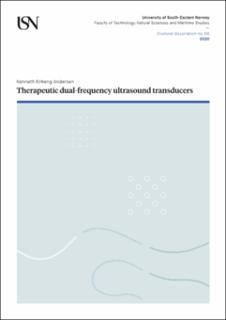| dc.description.abstract | The interaction of ultrasound with organic and non-organic matter has opened up for a vast industry. Arguably, in medicine, the most known application of ultrasound is diagnostic imaging of fetuses. However, ultrasound can be used as a therapeutic agent, too. Examples of treatments utilising ultrasound include treatment and surgically removal of solid malignant tumours; to disintegrate kidney stones; in combination with microbubbles, to increase the efficacy of a wide range of drugs and to help drugs pass the bloodbrain barrier — to name but a few.
Typically, the tissue volume to be treated is hidden from the physicians’ view and, because of this, both ultrasound or magnetic resonance imaging (MRI) are used to guide the therapeutic ultrasound. Although MRI exhibits excellent image quality, it is expensive and not portable. Ultrasound diagnostic imaging, on the other hand, is inexpensive, portable, and exhibits excellent image quality, which renders it a good imaging candidate for the ultrasound therapeutic applications. One challenge with designing a combined ultrasound imaging and therapeutic system is found in the respective centre frequencies. Due to tissue absorption and image resolution, the therapeutic centre frequencies are often much lower compared to the imaging centre frequencies, respectively. Because of this, a combined ultrasound imaging and therapeutic system may require transducers than can operate beyond the bandwidth limitation (˷100%) of conventional piezoceramic transducers.
The current thesis aims at investigating transducer designs and optimisation methods for so-called dual-frequency transducers applicable for ultrasound therapeutic applications. A dual-frequency transducer is defined as a transducer that accommodates two usable frequency bands in the same transducer, where the two frequency bands could not have been realised using only the fundamental frequency band. A dual-frequency transducer is typically realised by use of two piezoceramics in different mechanical and electrical configurations. The piezoceramic can be placed next to each another or on top of each other, and the piezoceramics can be of comparable thicknesses or of very different thicknesses; however, a dual-frequency transducer may also be realised by exploiting the inherent harmonics in a single piezoceramic.
A challenge when designing a dual-frequency transducer is how to transfer the mechanical energy to the radiation medium. For this purpose, conventional transducers utilise one, or several, quarter-wave impedance transformers of a specfiic acoustic impedance. For certain dual-frequency transducer designs, the two frequency bands radiate through different apertures; however, this is not always the case. If the two frequency bands radiate through the same aperture, conventional optimisation methods based on quarterwave impedance transformers may not be used.
Because of this, in Paper A, we designed a new numerical optimisation method for conventional and dual-frequency transducers. The method is based on a mathematical theorem and linearises the phase spectrum of transducer transfer functions. The linearisation is performed in a relevant frequency band, and can be performed on multiple frequency bands simultaneously.
Paper B and C are concerned with the designing, optimisation, and testing of a dualfrequency transducer and accompanying laboratory set-up for pre-clinical testing of Acoustic Cluster Therapy on tumours in mice. A motivation for this project was to simplify the existing laboratory set-up and workflow procedures to help mitigate human errors. The dual-frequency transducer replaced the existing laboratory set-up comprised of two different transducers which had to be carefully aligned to sonicate the tumour adequately. In total, six dual-frequency transducers and laboratory set-ups were manufactured which are currently in use at different research institutions around the world.
Paper D analyses a dual-frequency coupled resonator transducer (CRT). The CRT is comprised of two piezoceramic layers with a polymeric coupling layer sandwiched in between the piezoceramics. Depending on the electrical configuration, the CRT exhibits two usable frequency bands: One for short imaging pulses and another for longer, therapeutic pulses. The dual-frequency CRT has not received much attention in the literature, which motivated an analytical approach. Distributed, lumped, and mass-spring models describing the low-frequency band were developed, resulting in closed-form expressions for the resonance frequency. | en_US |
